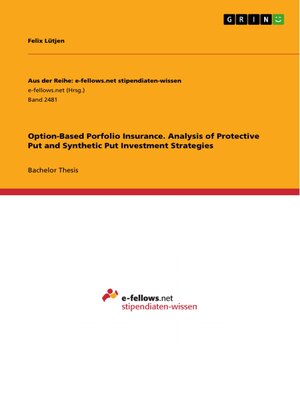Option-Based Porfolio Insurance. Analysis of Protective Put and Synthetic Put Investment Strategies
ebook ∣ Aus der Reihe: e-fellows.net stipendiaten-wissen
By Felix Lütjen

Sign up to save your library
With an OverDrive account, you can save your favorite libraries for at-a-glance information about availability. Find out more about OverDrive accounts.
Find this title in Libby, the library reading app by OverDrive.



Search for a digital library with this title
Title found at these libraries:
| Library Name | Distance |
|---|---|
| Loading... |
Bachelor Thesis from the year 2016 in the subject Business economics - General, grade: 1.7, University of Frankfurt (Main), language: English, abstract: Risk aversion is a common trait among investors. While it is possible to reduce risk attributed to specific industries and regions by diversifying among different securities, market risk affects all securities on the market. Even a perfectly diversified portfolio is subject to systematic or market risk. It can be managed through diversification across asset classes, for example by shifting some of the funds invested into risk-free assets. For some investors, this yields unsatisfactory results as the expected return directly decreases linearly with an increase in the position in the risk-free asset. Portfolio insurance (PI) describes an alternative set of strategies that allows investors to reduce their exposure to market risk by guaranteeing the value of the portfolio to be above a certain value at the end of the investment period while allowing for participation in rising stock markets. Option-based portfolio insurance (OBPI) refers to a set of strategies in which either a conventional put option (protective put) or a replicated put option (synthetic put) is used to insure a portfolio against adverse price movements. In theory and assuming perfect market conditions, protective put (PP) and synthetic put (SP) yield identical payoffs and have the same cost. In practice, there are several important differences between the two strategies. On the one hand, PP seems to be an easy and uncomplicated strategy to implement, but the unavailability of listed options with desired maturities and strike prices are major issues. SP strategies, on the other hand, can suffer from obstacles like high transaction costs and jumps in stock prices.







